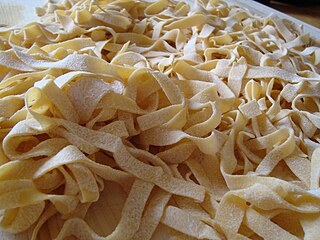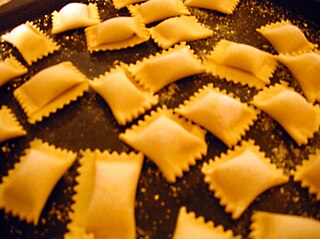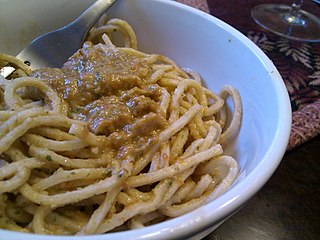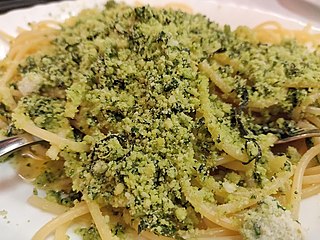
Pesto or more fully pesto alla genovese is a paste made of crushed garlic, pine nuts, salt, basil leaves, grated cheese such as Parmesan or pecorino sardo, and olive oil. It originated in the Italian city of Genoa, and is used to dress pasta and sometimes soups.

Fettuccine is a type of pasta popular in Roman cuisine. It is descended from the extremely thin capelli d'angelo of the Renaissance, but is a flat, thick pasta traditionally made of egg and flour. At about 6.5 mm, it is wider and thicker than, but similar to, the tagliatelle typical of Bologna, which are more common elsewhere in Italy and is often used as a synonym. Spinach fettuccine is made from spinach, flour, and eggs.

Ziti, also zite, are a shape of extruded pasta originating from the Italian regions of Campania and Sicily. They are shaped into long, wide tubes, about 25 cm long, that need to be broken by hand into smaller pieces before cooking. Ziti have similarities to bucatini, but are much thicker.

Cannelloni are a cylindrical type of egg-based stuffed pasta generally served baked with a filling and covered by a sauce in Italian cuisine. Popular stuffings include spinach and ricotta or minced beef. The shells are then typically covered with tomato sauce.

Agnolotti is a type of stuffed pasta typical of the Piedmont region of Italy, made with small pieces of flattened dough folded over a filling of roasted meat or vegetables. Agnolotti can be di magro or di grasso depending on their filling of vegetables or meat.

Spaghetti alla puttanesca is a pasta dish invented in Naples in the mid-20th century and made typically with tomatoes, olive oil, olives, anchovies, chili peppers, capers and garlic, with vermicelli or spaghetti.

Campanelle is a type of pasta which is shaped like a cone with a ruffled edge, or a bell-like flower. It is also sometimes referred to as gigli or trompetti. It is intended to be served with a thick sauce, or in a casserole.

Bigoli is an extruded pasta in the form of a long and thick strand. Initially bigoli were made with buckwheat flour, but are now more commonly made with whole-wheat flour, and sometimes include duck eggs. The preparation is then extruded through a bigolaro, from which the pasta gets its name.

Corzetti or croxetti are a type of pasta typical of the Ligurian cuisine of northeast Italy, and traditional also in the area of Novi Ligure just across the border with Piedmont, in the province of Alessandria. Corzetti originated in Liguria, in northern Italy along the border with France, during the Middle Ages. The name itself derives from a 14th century Genoan coin, the corzetto.

Paccheri is a type of pasta in the shape of a very large tube, originating from the Campania region of Italy. They are generally smooth, but there is also a ribbed version, paccheri millerighe. The name comes from Neapolitan paccharia, 'slaps', with a depreciative -ero to indicate something common. The name has been ascribed to a slapping sound they may make when eaten. They can be served stuffed.

Pesto alla trapanese is a Sicilian variation of pesto, typical of the province of Trapani. It is also known as pesto trapanese and pesto alla siciliana, and as pasta cull'agghia in the Sicilian language. It is made of garlic, basil, almonds, grated pecorino siciliano, tomatoes, salt, and black pepper, and bound with extra virgin olive oil.

Pasta con le sarde is a Sicilian pasta dish with sardines and anchovies. It is recognized as a traditional Italian food product in the prodotto agroalimentare tradizionale (PAT) scheme of the Italian government. It is most associated with the city of Palermo, but it can be found all over the island.

Sedani is a type of pasta slightly larger than macaroni, with a similar slight bend. They can be smooth (lisce) or furrowed (rigati).

Tortiglioni are a type of pasta similar to rigatoni, but larger and with deeper grooves which spiral around the pasta.

The capuliato or capuliatu is a traditional condiment of Sicilian cuisine based on dried tomatoes, linked, in particular to the territory of the Vittoria Plain, in free municipal consortium of Ragusa. The original name is capuliato, meaning 'minced'.

Ligurian cuisine consists of dishes from the culinary tradition of Liguria, a region of northwestern Italy, which makes use of ingredients linked both to local production, and to imports from areas with which, over the centuries, the Ligurians have had frequent trade.
Pasta chi vrocculi arriminati is a pasta dish originating in the Palermo region of Italy. It generally consists of a long pasta such as spaghetti or bucatini, cauliflower, onion, raisins, anchovies, pine nuts, saffron, red chili and breadcrumbs. Traditionally, it was made with bucatini. The name arriminati means 'mixed' and refers to the process of mixing until the cauliflower forms a creamy sauce.

Spaghetti alla carrettiera is a pasta dish originating in the Platani Valley, nowadays more common in eastern Sicily. It is generally made with spaghetti, garlic, chili pepper, pecorino siciliano or breadcrumbs, parsley, and olive oil for dressing, and commonly tomato is added. Sometimes additional ingredients such as anchovies, capers, almonds or pine nuts and white wine are also included. The oral tradition is that the pasta dish originated with carters who brought the dish prepared in advance, on their wagons for lunch.


















